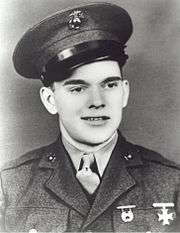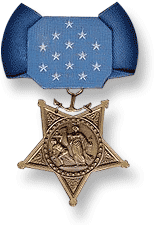Leonard F. Mason
| Leonard Foster Mason | |
|---|---|
  PFC Leonard F. Mason | |
| Born |
February 22, 1920 Middlesboro, Kentucky |
| Died |
July 22, 1944 (aged 24) DOW in Guam |
| Place of burial | Honolulu, Hawaii[1] |
| Allegiance | United States of America |
| Service/branch | United States Marine Corps |
| Years of service | 1943 - 1944 |
| Rank | Private First Class |
| Unit | 2nd Battalion, 3rd Marines |
| Battles/wars | Battle of Guam |
| Awards | Medal of Honor |
Leonard Foster Mason (February 22, 1920 – July 22, 1944) served in the United States Marine Corps during World War II. He was posthumously awarded the Medal of Honor for heroism during the Battle of Guam where he was mortally wounded.
Biography
Leonard Foster Mason was born on February 22, 1920 in Middlesboro, Kentucky. He enlisted in the Marine Corps in April 1943 and was promoted to private first class in March 1944.
During the landing on Guam, on July 22, 1944, two enemy machine guns opened fire on Mason's platoon. Although mortally wounded, Mason cleared out the hostile position, acting on his own initiative. His heroic act in the face of almost certain death enabled his platoon to accomplish its mission. He posthumously received the Medal of Honor. Mason died the following day of his wounds.
Medal of Honor citation
Rank and organization: Private First Class, U.S. Marine Corps. Born: February 2, 1920, Middlesboro, Ky. Accredited to: Ohio.
- Citation
For conspicuous gallantry and intrepidity at the risk of his life above and beyond the call of duty as an automatic rifleman serving with the 2d Battalion, 3d Marines, 3d Marine Division, in action against enemy Japanese forces on the Asan-Adelup Beachhead, Guam, Marianas Islands on 22 July 1944. Suddenly taken under fire by 2 enemy machineguns not more than 15 yards away while clearing out hostile positions holding up the advance of his platoon through a narrow gully, Pfc. Mason, alone and entirely on his own initiative, climbed out of the gully and moved parallel to it toward the rear of the enemy position. Although fired upon immediately by hostile riflemen from a higher position and wounded repeatedly in the arm and shoulder, Pfc. Mason grimly pressed forward and had just reached his objective when hit again by a burst of enemy machinegun fire, causing a critical wound to which he later succumbed. With valiant disregard for his own peril, he persevered, clearing out the hostile position, killing 5 Japanese, wounding another and then rejoining his platoon to report the results of his action before consenting to be evacuated. His exceptionally heroic act in the face of almost certain death enabled his platoon to accomplish its mission and reflects the highest credit upon Pfc. Mason and the U.S. Naval Service. He gallantly gave his life for his country.
Namesake
In 1946, the destroyer USS Leonard F. Mason (DD-852) was named in his honor.
In 2013, the City of Middlesboro, Kentucky renamed a portion of Cumberland Avenue- the city's main street through historic downtown- in his honor; Leonard F. Mason Medal of Honor Memorial Highway.
See also
Notes
- ↑ "Medal of Honor recipient Burial Sites". HomeofHeroes.com. Retrieved 2008-10-28.
References
- This article incorporates text from the public domain Dictionary of American Naval Fighting Ships.
- "Private First Class Leonard F. Mason, USMCR". Who's Who in Marine Corps History. History Division, United States Marine Corps. Retrieved 2008-10-28.
- "Leonard F. Mason". Dictionary of American Naval Fighting Ships. Naval History & Heritage Command, Department of the Navy. Retrieved 2008-10-28.